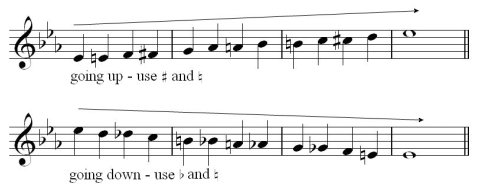

These are even easier to understand because all we do is approach a chord tone chromatically from above or below. Try playing up and down this scale line and see if you can hear the difference:Īs well as passing notes we can also use Approach Notes. It’s also worth bearing in mind that these passing notes are easier to use when we’re moving towards a chord tone.įor example, the flattened second, the Bb, is much more suited to approaching the root note (a chord tone) than it is to approaching the second degree (a non chord tone) so I’d be more likely to use it in descent.

Here are some examples of chromatic passing notes in our A Mixolydian scale: So for a chromatic passing note we’re simply going to pass from one scale note to the next using the chromatic note in between. Click Here For More Information! Chromatic Passing Notes
#Chromatic notes how to
You’ll learn the construction of EVERY chord you’ll ever encounter, how to view them over the entire neck of the bass and how to apply them in your basslines, fills and solos. That way we get to learn the application as opposed to just what the notes are.Īgain, if you need any help understanding chord tones or how they relate to the bass fingerboard, be sure to check out the Chord Tone Essentials course. Now in adding chromatic notes, the notes between those scale tones, we’re going to use two simple melodic devices in the shape of passing notes and approach notes. In the 2nd lesson we filled in the gaps between those notes with the A Mixolydian scale which gave us A B C# D E F# G. In the first lesson we used chord tones for our fill so that was using the arpeggio of A (The notes A C# E and G) Our backing track and bass line are as follows: Just as in the previous lesson we’ll be working over a I-VI-II-V progression in the key of D Major: Dmaj7 – Bm7 – Em7 – A7 They just add that nice bit of spice to the line. We didn’t linger on them.Ĭhromatic notes contain a lot of dissonance and tension, which is great, but tension begs to be released and because we’re just rhythmically skipping through them we don’t draw much attention to them. So can you see anything in common there with all three of those riffs? Well, the chromatic notes in there were used in passing. Here we’re in the key of Bb minor and this riff makes use of both a B natural and an E natural.

Ain’t No Stopping Us Now – McFadden & Whitehead We are in the key of B Major, so again this is a chromatic note. In the ascending line we have a D natural between the C# and the D#. There is no Ab in any D minor scale so this ‘blues’ note is chromatic. This riff is in the key of D minor but we have an Ab in there. So, as an example of how common chromatic notes are in modern music, here are three famous riffs making use of chromatic notes: Sunshine Of Your Love – Cream You’ll hear chromatic alterations to chords and chromatic melody notes all the time and they can add a lot of interest to our music. Well the answer is not at all and it’s actually rare you’ll ever hear a complete modern song or piece of music made up entirely of diatonic notes. Now you might be thinking, well that’s all well and good but if Chromatic notes are outside of the key, aren’t they going to sound weird or just plain bad when we use them in our playing? These are the diatonic notes.Īny other notes, C# or Db, D# or Eb, F# or Gb, G# or Ab, A# or Bb. Our main palette of notes will be using the C major scale: C D E F G A B. So diatonic is in key, chromatic is out of the key. This is the opposite of diatonic notes which are in key. So first of all, what are chromatic notes? Well, chromatic notes are notes outside of our main tonality or key.


 0 kommentar(er)
0 kommentar(er)
